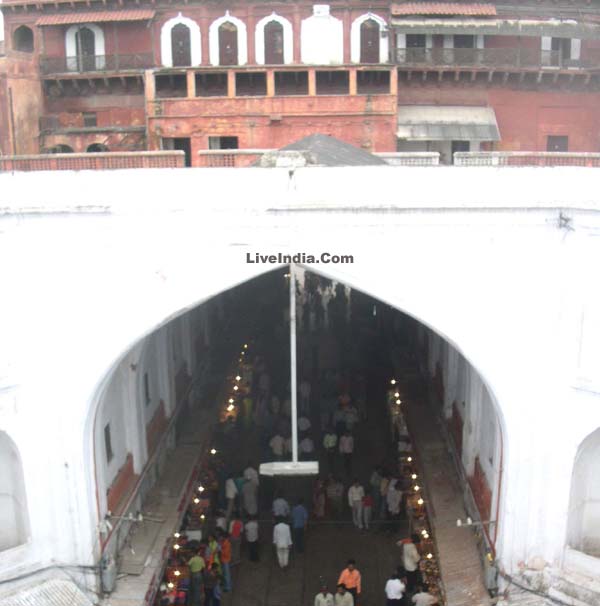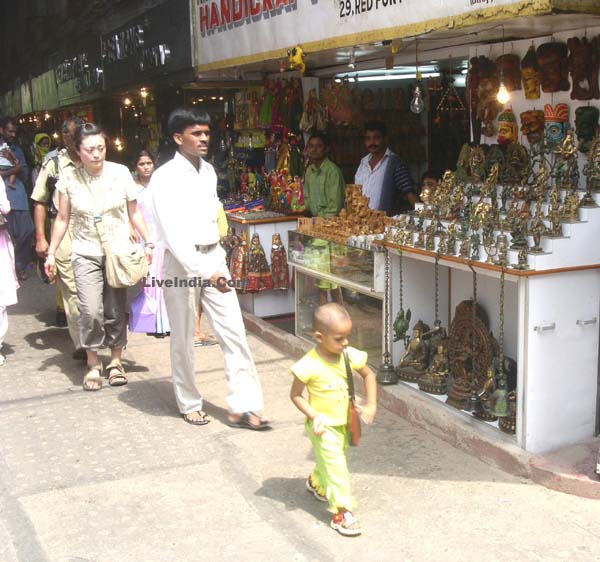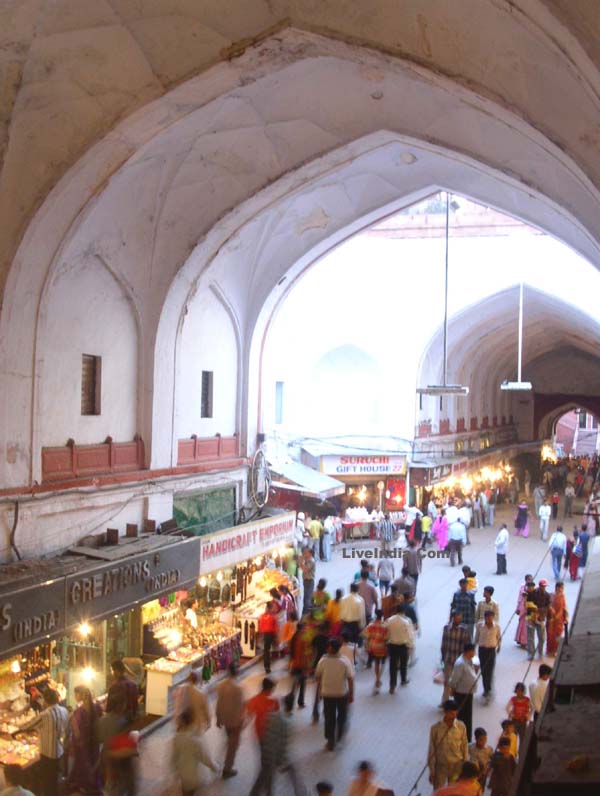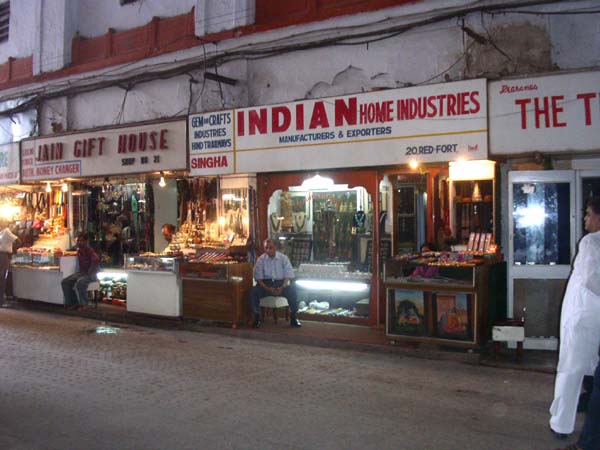Meena Bazaar
Meenā Bāzār or Mina Bazaar (Urdu:مینا بازار, Hindi: मीना बाज़ार) is a special bazaar to sell items to raise money for charity and non-profit organizations. It also refers to a number of modern-day shopping centres and retail stores.
In the Mughal era
During the Mughal era Meena Bazaars, also known as Kuhs Ruz ("Day of Joy") were exclusively held for women, while the emperor and a few princes were the only males present.
The Bazaars took 5 to 8 days during theNorouz (New Year) festival. EmperorHumayun was the first to organize them, butAkbar and his successors made them more elaborate.
The fair was closed for the public, while the women of the harem, Rajput ladies and the wives and daughters of the noblemen in the court, set up their own stalls to sell cloth, jewellery, handicrafts etc.
Only the emperor, princes and some nobles were allowed to enter the bazaar to purchase the goods, which were sold at high prices. The earnings were given for charity.
Other
In India, Meena Bazar, refers also to a bazaar of the famous Qaisarbagh in the city ofLucknow in the Awadh region of the country.
This bazaar was enjoyed by the royal ladies living in the Qaisarbagh complex of Nawab Wajid Ali Shah.
In Pakistan, the Meena Bazaars are organized by students of schools, colleges, universities, and other non-profit organizations to raise money for their activities.
In the United Arab Emirates, Meena Bazaar is the name of a well-known shopping location in Bur Dubai. Since 2000, Meena Bazaar is also becoming popular among tourBazaar,
Where is Meena Bazaar in Dubai?
Meena Bazaar is a shopping area located close to Khalid Bin Waleed Street in Bur Dubai. You can get there by car there are several parking lots in the area but getting a parking space is like hitting the jackpot.
For a more stress free shopping at the Meena Bazaar use the public transportation network. You can easily get there by bus, C7 stops at theFaheidi, Roundabout or use the Dubai Metro and get off at Al Fahidi Metro Station 2 on the green line.
Meena Bazaar Map
The short history of the Meena Bazaar
Meena Bazaar was originally called Cosmos Lane, but taxi drivers in Dubai began calling it Meena Bazaar because of the many well-dressed mannequins of the textile stores on Al Fahidi street resembled Delhi’s Meena Bazaar. In the 1970s a shop in Bur Dubai changed its name from Shardha Trading to Meena Bazaar, and the title caught on from there. Today Meena Bazaar is a perfect option for old-fashioned shopping in Dubai.
Opening hours at the Meena Bazaar in Dubai
If you would like to go on a shopping spree at the Meena Bazaar in Dubai please note that shops are open from Saturday to Thursday between 08:00 GST and 23:59 GST, Friday from 14:00 Gulf Standard Time until midnight.
Shops are closed daily during lunch break usually lasting 30 minutes to an hour. Please note also that during the Ramadan the working hours in the UAE are reduced by two hours per day.
Jewllery & diamond shops
The first jewellery shop in Meena Bazaar area opened in 1982 after several gold stores from Deira Gold Souq moved to the area for cheaper rents. Today the Meena Bazaar shopping area is full of diamond and gold shops where you can buy jewelry at half price.
Food and drink at the Meena Bazaar
Sometimes shopping around can be exhausting. But don’t worry, there are plenty of coffee shops and restaurants in Bur Dubai where you can recharge your batteries, taste the oriental cuisine and drink a cup of hot coffee.
Rangoli Restaurant Bur Dubai
The Rangoli is a vegetarian restaurant at the heart of the Meena Bazaar serving Gujarati buffet, South Indian dishes and fresh juices. A perfect spot for breakfast, lunch or dinner.
Location
Meena Bazar (Cosmos Lane)
51375 Dubai
United Arab Emirates
51375 Dubai
United Arab Emirates
Driving around the Meena Bazaar – VIDEO
Meena Bazaar is a shopping area not a single souq or bazaar it’s rather a conglomerate of shopping streets in Bur Dubai. Come take a drive with us.
A day at the Meena Bazar
I am not so fond of being in crowded places, but that day, I was compelled to be at theMeena Bazar Bur Dubai a popular market in Dubai.
It all started on a Thursday evening, when my brother came to my place and we were planning to buy wedding clothes for him online. In spite of trying to convince him to get his accurate measurements from a local tailor so that we could order them, he did not heed my advice. Therefore, the following day, we decided to search for a wedding suit for him, as well as bridesmaid clothes for my four-year old daughter.
That Friday, being a weekend in Dubai, all shops were to open at around four in the afternoon. Meena Bazar, located in Bur Dubai area, was about forty minutes drive from my residence. So, I set off at around three o’clock, with Beenal and Pravesh. On the way, we chatted, listened to music in the car and Pravesh was so excited that he kept on checking his long list to see if he had missed anything.
I looked at him, a bit irritated, when he uttered happily, “Come on, it’s the first time I am getting married!’’
“It better be the last!’’ I replied.
Soon we could hear ourselves laughing to the top of our voice. I always loved to be around my only brother. We were in separable since childhood and until now we still are. We consider ourselves lucky to have been able to move to Dubai in 2005, on the same flight, with the same company. Meanwhile, Beenal was busy admiring the skyscrapers on the famous Sheikh Zayed Road. At four, she was smart enough to know some of the names of the buildings- like Burj Al Arab, Burj Khalifa.
Finally we reached Bur Dubai and now we had to hunt for a free parking space. Parking was one of the reasons I hated to be there. I drove round and about and when I could not find any space, I decided to look for paid parking, which I managed to spot. As we got down from the car to wander, we saw that the narrow streets were already congested with bicycles, cars and people. But what I liked about Meena Bazaar, was that it was so lively, with people speaking different languages and of different nationalities; Indians, Pakistanis, Arabs, Africans, Afghanis, to name a few. There were so many shops where you could purchase clothes for all occasions, jewelries in unique models, shoes of different designs, tapestries like those in the fairy tales of “Aladdin and the Lamp” and foods from international cuisines.
However, there were many hawkers who would be following you and requesting you to buy stuffs which were supposedly branded, but a very low cost. There would be items like ‘leather’ watches, bags, shoes and reputed designers’ sunglasses.
Nonetheless, we managed to find a shop where we could buy all the stuffs we were looking for all-in-one place how time-saving it was! Although bargaining was not authorized, we managed to get discounts and high class service for being ‘good’ buyers.
On the other hand, seeing Beenal so overwhelmed at discovering a totally new environment made me also feel quite comfortable, as it was something different from our routine-like an adventure. So, from that day onwards, I decided that I would visit Meena Bazar again, only when it would be required.
Meena Bazaar, Karachi
Meena Bazaar is said to be the oldest women market in Karachi, Pakistan. It's a shopping street only for women carry number of things at very cheap. The market is very hard to guess the adjustment path, but when you leave the main road and enter the narrow streets that wind through the market. In Meena Bazaar you can simply astonished at the original use of limited space for merchants.Address: Karimabad Roundabout of Gulberg Town, Karachi, Pakistan
The linearity of this market has formulated a strong longitudinal link and emphasized the straight axis with the Naubat-Khana & Diwan-i-Am. Walking through the Lahori-Gate one immediately enters this covered two storied arcade, with octagonal court in the middle for sunlight & natural ventilation, known as 'Chhattar Manzil' which divided the market into two sections, eastern and western, which have vaulted roofs supported on series of broad arches given at regular interval. Their edges, supported by stone and the intermediary space ( i.e. a vault) bears stalactite (honey comb motifs) in stucco, which has been universally used in Islamic art, structurally as well as ornamentally. As it appears, the whole of the market, in the interior and on the exterior, was originally stuccoed, painted and gilded to give a gorgeous effect. Bazaar on each side contained 32 arched bays that served as shops, just as they do today. The lower cell consisted of two rooms, the front one was possibly used for the actual display and the one at the back for storage, manufacture or business transaction. The upper cells may perhaps have been used for the official transactions related to the commercial function.
Anirudh Singha Secretary, Red Fort Bazar Shopkeepers Association anirudh singha <anirudhsingha15@gmail.com> .jpg) | |||
 As you enter the Lahore Gate, arcaded apartments flank the passage, which is known as Chatta Chowk. Also known as Meena Bazaar, this was one of the first covered bazaars of the 17th century. | |||
 The shops of that era sold pure silks, jewellery, gems, silver ware and other artistic objects and catered primarily to Mughal courtiers and noble families. It is said that there were also teashops here, where nobles used to meet and discuss the latest court gossip and news of the kingdom. Today the shops in the Chowk sell souvenirs and eatables and drinks. They are now located only in the lower arcade whereas in Mughal times the shops were located on the upper as well as lower arcades. | |||
 These vaulted arcades are made up of natural sandstone. The shops in the lower arcade had cusped arches. In the middle of the Chatta Chowk, there is also an open section for the sunlight and fresh air to enter. From the end of the bazaar, the view of Drum House was picturesque as the large square courtyard and water tank, provided a clear view, unlike later when much was altered with the British occupation. They destroyed the elegance of the monument by building multi-storey barracks north of the courtyard | |||
.jpg)
Rajinder Pershad Jindal
Delhi, India
(+919650891738)
|









No comments:
Post a Comment